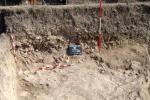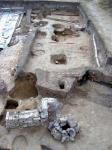Summary (English)
PLISKA (Pavel Georgiev – pavel_g@gbg.bg, Radoslav Vasilev, Tihomir Tihov, Gergana Ilieva) Debris was discovered over an area of c. 20 sq. m located in Trench XX, in the middle of the Small Timber Fortification. The debris consisted fragmentary mortar, bricks, roof-tiles, terracotta pipes from water-conduits, terracotta pipes from wall hypocausts and stones. The building material that was suitable for reusing was extracted from the debris around the middle of the 10th century, at the latest. Only the dugout part of the building was preserved, 6.90 m by 3.45 m in size, and sherds of the 9th – 10th centuries and animal bones were found. A layer of mortar up to 15 cm thick was documented on the floor and a pavement of bricks of the hypocaust was constructed above it. The room belonged to a domestic bath located in an aristocratic residence inside the Inner Town, dated around the middle of the 9th century AD, at the latest. The residence was related to a new phase in the urbanization of the Inner Town that occurred during the reign of Prince Boris I (AD 852 – 889). According to the historical sources, there were residences of the boyars from the Prince’s entourage built in Pliska in that time. Sunken-floored houses of a settlement of the second half of the 10th – first decades of the 11th centuries were explored in the periphery of Trench XX. Earlier sherds were discovered in sunken-floored House No. 21 which dated to the end of the 9th century AD, at the latest. Two storage pits were explored, one of them containing a gilded bronze belt appliqué and sherds of the end of the 10th – beginning of the 11th centuries. Christian burials Nos. 12 – 14 were explored, dated before the end of the 10th century. The finds from the excavations included two anonymous Byzantine folles of the Class A2 and the Class D (dated to AD 1050 – 1060), which is the latest coin discovered in Trench XX.
- Pavel Georgiev - Shumen Branch of the Archaeological Institute and Museum
- Radoslav Vasilev - Archaeological Institute with Museum
- Tihomir Tihov - Regional Museum of History – Shumen
Director
- Gergana Ilieva - Regional Museum of History – Shumen
Team
Research Body
- Archaeological Institute with Museum
- Shumen Branch of the Archaeological Institute and Museum






![Download [PDF]](/excavation/skins/fasti/images/results/download_sml.png)

